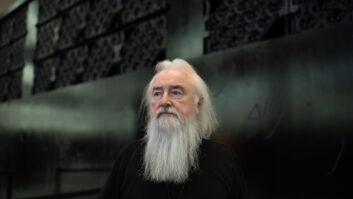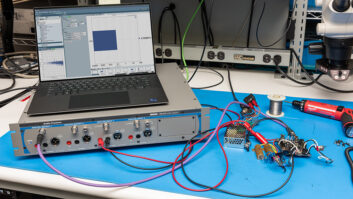
Don’t skip Part 1!
STEERING, CONTROL. 3D IMMERSION
Based in Berlin, Holoplot has been researching sound control for over a decade, combining two principal technologies into its DSP-driven speakers. Initially, the company’s products were installed to bring intelligibility and location-specific audio to challenging acoustic environments such as train stations and houses of worship. More recently, the company has turned to live entertainment applications. “Everything we do is about controlling sound,” says Holoplot CEO Roman Sick, “If you can control the sound, you can ultimately control the experience.”
One of Holoplot’s integrated technologies is three-dimensional beamforming, Sick notes, which can deliver consistent coverage over a precisely defined area. “It’s not only steering the sound away from the walls and the ceiling, but it’s shaping the wavefront in such a way that you have a very consistent throw over a large area. Everyone in the audience can have a much more equal experience.”
Second, he says, “We have the immersive, wave field synthesis side, which is about bringing that dimension of audio closer and more realistically to the audience.” Using wave field synthesis, developed in the late-1980s, DSP can position a sound in a precise spatial location such that it sounds close to the listener even though the source is far away.
All that said, what is under the hood is really not important to users, Sick stresses. “They don’t see which part of the technology they’re using. They define what they want to achieve, and we combine these two things to ultimately get to the best result.”
To further enhance the immersive experience, 10,000 of Sphere’s seats are outfitted with Powersoft Mover, which harnesses a patented moving-magnet technology in an infrasound haptic system that the manufacturer calls “revolutionary.” Those haptic seats are driven by 2,500 audio channels from 718 Powersoft Quattrocanali amplifiers. Director Darren Aronofsky’s film Postcard from Earth, which premiered at the venue on October 6, playing between U2 show days, was the first event to engage the venue’s experiential seating.

BUILDING THE B-CHAIN
When Dolan floated the idea a couple of years ago of U2 opening MSG’s Sphere, Joe O’Herlihy, who has been the band’s FOH engineer for 45 years, flew to Germany to evaluate the Holoplot X1 system. He arrived with live multitrack recordings from U2’s last jaunt, 2019’s The Joshua Tree Tour, from four different acoustic environments—specifically, arenas and stadiums, both open and enclosed. “I was totally floored by the demo. The intelligibility was incredible,” O’Herlihy comments. “I could hear Bono as if he was right in front of my face.”
What’s more, he says, “I could walk right up to the 160 X1 arrays on the stage with Bono’s vocal microphone in hand, stick my head into the speaker and…total rejection, no feedback. I thought, ‘How are you doing this?’ I was so impressed, I stayed for the week.”
Jim Griffiths, director of U.K.-based environmental and technology consultants Vanguardia, who has known O’Herlihy since 1987, even employing him on several projects, confirms, “Joe came along, ran the system up to 104, 105 dBA, and it started to sound like a P.A. And then he just didn’t want to leave.”
Vanguardia was appointed five years ago, Griffiths says, reporting to Dibble, CEO at MSG Ventures, Sphere Entertainment’s technology division, initially on design and construction in London, where the company plans to build another Sphere. Working alongside technologist Erik Hockman, SVP and senior fellow at MSG, Griffiths’ firm was engaged to review the Las Vegas AV systems and acoustics, evaluate the loudspeaker options and ultimately put the Holoplot array through its paces, in Germany then at Rock Lititz in Pennsylvania.
Vanguardia’s scope of work also included modeling the impact of the proscenium P.A. setup on the band and the audience on the floor, advising on the stage design in terms of acoustics and sound, and providing site acceptance tests. “We were the ears and eyes of MSG; it was quite a big role,” says Griffiths. One recommendation, a change to the structure and acoustic treatment in Sphere’s roof, “probably saved MSG around $10 million,” he comments.
When O’Herlihy returned from Germany, his report to U2 was unequivocal: “I said, ‘You guys have to open the Sphere. You have to be the first, because we have been the leaders in the field for such a long time.’ This is going to be the future for our industry, for the next 10, 15, 20 years.”





